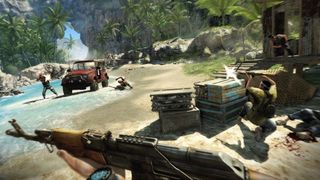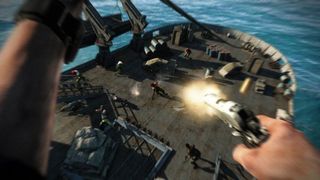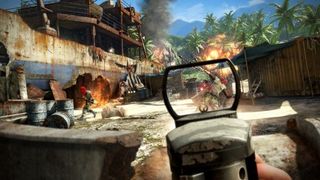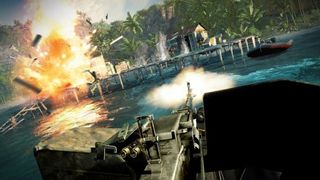Far Cry 3 preview

Our hero isn't a hero – at least not the way we expect our shooter heroes to be. He's Jason Brody, college student and backpacker, the kind of guy you unfriend on facebook because he won't shut up about how he found himself in Thailand. But rather than finding himself, Brody and his friends are found by the aforementioned Vaas, doolally leader of a gang of human traffickers, and taken to Far Cry 3's island.
Ubisoft Montreal want Brody to be an everyman, thrust into an extraordinary situation. Escaping his captors, Jason's story becomes part revenge fantasy – the kind of “I could do better” thoughts we have during horror films when characters drop guns or split up to hide in attics – and part pure survival. Jason wasn't captured alone, and his friends weren't necessarily as lucky as he was in his escape. It's this that keeps him on the island, rather than trying to make a raft out of coconuts to escape the place, as Dan Hay explains: “The recipe for us is: Jason, remember your friends and find them.”
Dan describes Jason as “pretty urban, pretty normal.” Playing that guy – someone who'd fumble a grenade and blow his legs off, or leave the safety on during a shootout – would be frustrating. The Jason I was shown in the first of Far Cry 3's missions was able to clear out corridors with one clip of ammo, was able to take bullets and shrug their effects off. Jason is changing. Dan puts it in context: “if he was to call his mom at the beginning of the game, she'd say 'my boy is safe, everything is good.' But if he was to survive this, she would hear something different in your voice, she'd know he'd been through something, and she'd recognise him as a different person.”
That change isn't necessarily of Jason's own volition. Dan suggests that instead, it's the island changing Jason. “Jason's got a tattoo. [A Polynesian-style set of symbols down his left arm.] Where did it come from? He didn't arrive on the island with it. The story of the island is being etched on his body.”
In game terms, Jason's growth means a wider range of ways to play. Killing enemies earns experience points, which in turn can be plugged into skills. Game designer Andrea Zanini wouldn't be drawn on many of these skills, but confirmed the knife-throwing double-takedown in the first mission I saw was the result of plugging these points into a specific place. You'll want to pick skills that augment the way you play: the knife-throw, for example, is ideal for players who want to get through the game without making a peep.

I asked Andrea if dedicated players could sneak through the entire game. His answer was careful: “We give you the choice to play how you want. If you want to play this mission stealthily, you can. But part of the theme and trying to survive on the island is keeping players on their toes. So every now and then we may switch it up. It's not, 'all of a sudden you're detected', but we increase that challenge level for you.”
Detection will be more organic than it was in Far Cry 2 – where laser-eyed eagle-people would spot you from a few miles over and lance you through the face with unerringly accurate sniper shots. Andrea elaborates: “We've completely rebuilt the AI, they're fully systemic and we really focused a lot on detection to make sure that it's clear to players when and where and why you got spotted.” The piqued interest of guards is now signified by a white circular pulse in the middle of the screen, with an arrow pointing in the spotter's direction. This system – demonstrated handily by a notably curious lizard chasing Jason down a hillside after he was eyeballed near its nest – looks both more forgiving and more sensible than Far Cry 2's inexplicable alternative.
The biggest gaming news, reviews and hardware deals
Keep up to date with the most important stories and the best deals, as picked by the PC Gamer team.
The need to find his friends before Vaas and his cronies do their worst pulls Jason along through the story, but with an island's worth of secrets to find and places to explore, Dan gives players an excuse to put the main questline on hold for short periods. “After a while, you start to go a bit... wild. You start to go like the island is calling to you. This island made Vaas. And the question is, if you stay on it long enough, what's it going to do to you?”
Dan and his team speak of the island as a character as much as the humans that inhabit it. In the other Far Cry games, the world was important for its space, not its content. This time around, Ubisoft Montreal have worked at creating a place. Level design director Mark Thompson has some examples. “When you're on the Medusa there's a waterfall in the background. There's a little cave behind the waterfall.” Dan Hay picks up the thread: “In the pool underneath the waterfall there's something! You look around behind you to where Vaas is bringing in ships and stripping them.

What's in them? What do you have to swim down and find? What's he doing? Why?” Dan wiggles slightly at he describes one tiny section of his game from memory. Mark's got more details: “there are still old temples that can be found. The island was involved in World War II, so there's all that layer of history as well from that conflict. Then as the island was industrialised after the war, the western world came for its resources. They mined it, pillaged it, and when the resources dried up, they left again. There's all these layers of story that are embedded in the world. And the player is free outside of missions to just go off and explore. They'll find stories: the story of one soldier, or the story of a certain conflict.”
Vaas's madness isn't the only brand of lunacy the island breeds. Mushroom man Dr Earnhardt is under the influence of both his own brand of fungi fumes and the island, but it manifests itself in different ways. Where Vaas shoots anyone he doesn't like, Earnhardt paints his house white once a week – hence the white flecks on his skin. What an unusual man he is.
The island also has a native population, and unlike the previous game, not everyone wants to kill you. “In Far Cry 2 there wasn't a concept of a population,” Mark says. “We really wanted a living breathing world where not everyone was an enemy. I'm not going to turn a corner and see a suicidal jeep flying towards me. In Far Cry 3, perhaps it's going to be a friend. He's going to drive past and he's going to go to the village.”
Villages offer further distractions from Jason's quest to find his friends, providing a place for players to “go to the bar to drink, play poker with the locals, and hear about what's happening on the island.” The wilderness is still hostile, but it seems to have been dialled back from Far Cry 2's homicidal mania. The most obvious symptom of this change is the game's checkpoints. Infamously in Far Cry 2, enemy soldiers would respawn at the game's many crossroads. Far Cry 3 turns these into outposts. Once players have cleared one, it stays cleared, acting instead as a safehouse. Mark stresses the point:
“They're dead, they stay dead, you come back and it's yours.”

They'll also provide a bolthole for other useful friendlies: “Perhaps there's a store there, perhaps people come and start to live there, almost like a mini village. The pirates have lost their control, and they fall back a little bit. And the world around that area changes: you see more friends, you get more opportunities to do quests.”
The third and final mission I'm shown takes place on board a ship. Like the mushroom cave, it looks linear: small corridors and a heavy guard presence means Brody relies on his pump action shotgun to negotiate his way to his objective deep inside the vessel. The sequence ends with the discovery of a bomb and the slow sinking of the ship. As Jason swims to safety, he's on a one-way path. Light appears at the end of the tunnel – a way to safety – and a song starts up. It's timed to kick in as Jason's vision is greying out from lack of oxygen, orchestrated to give the moment the maximum emotional potency. “From time to time in the story, when we want to capture a certain emotion – put Jason through a certain experience, then we take more control,” says Mark.
It seems, by Vaas's metric, that Ubisoft aren't insane. They're working to change Far Cry, fixing mistakes in the previous games and directing players to avoid the failures that unbridled freedom can bring.
But even with all of its changes, Far Cry 3's developers would never be able to resist the lure of choice. It's in their bones. After the demonstration concludes, I ask Mark if there was any other way Jason could've played the final, apparently linear mission. Cheerfully, he tells me: “Definitely! You can stealth your way through the ship, for example. When you open the first door, a guy will turn around. Kill him silently, and then you can move through that room and kill everyone else in there without making a sound.”
As they'd say in Ubisoft Montreal's French-speaking home city, plus ça change, plus c'est la même chose – the more things change, the more they stay the same.
Most Popular


